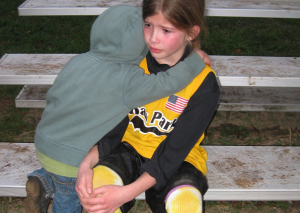Near Death Experiences


Last modified: 29-03-2020
Probably everyone has heard from more or less reliable sources about people who have survived clinical death and their stories about watching their body from the top, the light in the tunnel, and other mysterious experiences. Some argue that these experiences are proof of life after death, others treat such stories as fairy tales, and yet others try to explain scientifically. I searched some time ago online database of scientific journals and I want to introduce what about near death experiences (NDE) says modern science.
NDE is associated with a variety of experiences, including such as:
- The feeling of being dead.
- The feeling of leaving the body (OBE – out of body experience). OBE experience may be accompanied by so-called. autoscopy, or watching from the top of the body.
- Hearing a loud buzzing or ringing while leaving the body.
- The impression of being in a tunnel, at the end of which you can see a very bright light.
- Depending on religion, a vision of angels, God, Jesus, Mohammed and other deities or just a friendly person as in the case of atheists.
- The impression of walking into the clouds, space, heaven or hell.
- Seeing their deceased relatives or friends and chatting with them through thought.
- Overview of life – a person sees not only all the events of his life, but also all thoughts and notes how it affected her and others. During this experience, there is no time or space; everything is recalled during a moment. After regaining consciousness, a person can talk for hours about what she remembered during resuscitation lasting a few minutes.
- Impression of reaching a wall or other barrier. People who have had such an experience report that they had feeling that if they go to the other side, they will not come back to life. It was feeling so good that they do not want to go back, but at the same time something told them that they should come back because they still have much to do.
- At the end there is impression of returning to the body, associated with perception of pain.
Typical among those who have had such experiences, it is to change attitudes to life after reaching health. Such people become more helpful and religious develop their spiritual life, no longer afraid of death.
How common are near death experiences and who experiences it most often
Dr. Pim Van Lommel and his colleagues from the hospital Rijnstate in the Netherlands since 1988 to 2001, has been asking patients who have survived cardiac arrest, whether they remembered anything from the time when they were unconscious. Of the 344 patients, 62 (18%) had memories of that period. Approx. 50% of them were aware that they are dead, or was experiencing positive emotions, about 25% had out of body experience, 30% wandered through the tunnel, approx. 25% communicated with the “Light” or were watching the colors, approx. 30% observed the heavenly landscape or met dead people, 13% had overview of life, and 8% experienced coming to the border. Similar study also conducted American physicians (15.5% of 116 patients had an NDE) and British (11% of 63 patients talked about NDE).
Doctor Lommel cites in his work interesting story of one of the nurses. It’s about 44-year-old patient found on a street and transported to the hospital in a coma. The nurse before intubation of patient pulled out of his mouth denture teeth. After approx. 1.5 hours, the patient regained normal heart rhythm and blood pressure and, still in a coma, was transferred to the ICU. After more than a week, the nurse again met, already conscious patient. The man said that the nurse must know where his prosthesis is and accurately described where they were placed. This happened at a time when he was in a deep coma and during resuscitation.
Doctors from the Netherlands noted that the incidence of near-death experiences does not depend on the duration of cardiac arrest, the length of unconsciousness or of whether it was the need for intubation during resuscitation or not. They also did not find the relationship between frequency of NDE and given drugs, the intensity of the fear of death before the event, prior knowledge of the NDE, sex, religion or education. Higher incidence of near-death experiences has been demonstrated in patients under 60 years of age, patients who were resuscitated more than once during his stay in the hospital and in those who have already had such an experience.
Why do some people experience positive experiences near death, while for most people, an event that led to the cardiac arrest is a traumatic memory, often causing post-traumatic stress disorder?
This question tried to answer W.B.Britton and R.B.Bootzin – researchers from the University of Arizona. They studied brain function of 43 NDE survivors and compared them to a group of people who do not ever suffered injuries or life-threatening illnesses. They found that in people who have had near death experiences, more frequent we can see EEG patterns similar to the patterns of EEG in patients with epilepsy (this does not mean that these people also suffer from epilepsy). Epileptiform patterns were observed in these subjects in the left hemisphere and one in person in both. This is contrary to the assumptions of researchers who, knowing that the right temporal lobes may induce mystical experiences in people with epilepsy, they thought that the person who experienced NDE will also have anomalies in the right hemispheres. Respondents who experienced NDE, were also more likely than the control group to have symptoms such as sleepwalking, olfactory sensitivity, or hipergrafia, that is overwhelming desire for continuous writing. These symptoms also occur in people with epilepsy associated with temporal lobes.
There were also shown differences in sleep between people who had near-death experiences, and the control group. People who have had NDE slept on average an hour less, were less frequent in REM sleep (the stage in which dreams appear), but these phases have been longer. Psychological studies have also shown that people who have experienced NDEs are characterized by positive stress coping styles.
The researchers compared their results with those of other researchers who have studied people who survived life-threatening injuries. Results of other scientists say that epileptiform EEG patterns in people who have suffered no loss of consciousness due to head trauma, occur with a frequency of 5.7%. Of the 43 people who experienced NDE, 22% showed EEG patterns similar to those found in patients with epilepsy. These people also did not suffer a head injury, which suggests that the functioning of the brain in people who have had near-death experience is different than in people who have not suffered such experiences and the difference in the functioning is not the result of trauma. The fact that in people with epilepsy mystical experiences are evoked by the right temporal lobe, and the patients studied by researchers from Arizona revealed EEG abnormalities in the left temporal lobes, also suggests that people experiencing an NDE can be a specific group of people.
How can we scientifically explain near-death experiences
Many scientists believe that the near death experiences are the result of hypoxic brain. This is confirmed by the fact that impressions similar to those that describe people who survived cardiac arrest, are describes also by people who fainted and jets pilots who experience sudden large accelerations. During hypoxia, the field of vision “closes” from the edge toward the center, which might cause an impression to observe the light in the tunnel.
There is also a theory that NDE experiences are a kind of lucid dream, long-lasting state between sleep and wake. Out of body experience may be due to transient disturbances in the integration of visual, tactile, proprioceptive (from the body) and vestibular (related to body position) stimuli. Supposes of scientists that near death experiences, such as leaving the body are nothing more than the product of brain, are confirmed by the fact that they can be induced artificially stimulating certain areas of the brain. Stimulation of the connection of angular gyrus and supramarginal gyrus (area associated with integration of stimuli) and the rear part of superior temporal gyrus (area associated with self-perception) in right hemisphere can cause a feeling of separation from the body, but without feeling self-observation from above. There is also described one patient is who stimulation of the area situated moretowards the back, caused a sensation of leaving the body including autoscopy. Neurosurgeon Wilder Penfield, Nobel Prize winner, during epilepsy surgeries also sometimes caused experiences, similar to the way they describe people who suffered cardiac arrest. There were experiences, such as recalling memories from the past (but never overview of the entire life), the experience of light, voice or music, and in one patient the experience of leaving the body.
With the experience of leaving the body may also be related NMDA receptors. From the studies of drug users it is known that OBE can cause some of them, and above all, ketamine, which blocks NMDA receptors. These receptors are involved in the transmission of information from all the senses and their blockage can cause inability to integrate stimuli, which some scientists believe causes OBE.
Scientifically, as you can see we can explain a lot, but not everything. Because how to explain how it happens that near death experiences often occur when an EEG graph shows a flat line? On this question neurobiology and neurophysiology do not have the answers yet. Some deny that these experiences occur when the brain is not working and say that they occur when brain stops and when it starts to work. Others have speculated that maybe consciousness is not a product of brain cells and can exist independently of the mind. Perhaps that quantum physics is a branch of knowledge that can explain what consciousness is, not neuroscience. One of the people who are interested in these issues is Dr. Sam Parnia, a doctor who in 2008 together with a team of over 30 people began a study in order to determine whether those who claim that they were floating under ceiling and were watching their body actually were there (ie. if their consciousness was there), or is it just the result of anomalies in the functioning of the brain. Researchers placed in hospitals, in places were CPR are often performed images that can be seen only from the ceiling. Then, during interviews with survivors of cardiac arrest, they were going to check whether persons describing themselves watching from above, are able to say what pictures they have seen. Similar research have already been made by people involved in paranormal studies, but this study was the first in hospitals and the first which involved many people from the world of science and medicine – neuroscientists, doctors involved in resuscitation, psychiatrists, doctors from intensive care and others. What results? I will describe later :)
References:
- Ridder D., Laere K., Dupont D., Menovsky T., Heyning P. (2007). Visualizing Out-Of-Body Experience in the Brain. The New England Journal of Medicine, 357, 1829-1833.
- Wilkins L.K. i in. (2011). Ketamine as a primary predictor of out-of-body experiences associated with multiple substance use. Consciousness and Cognition, 20(3), 943-950.
- Lommel P.V. (2006). Near death experience, consciousness and the brain. A new concept about the continuity of our consciousness based on recent scientific research on near death experience in survivors of cardiac arrest. World Futures, The Journal of General Evolution, 62, 134-152.
- Morse D.R. (2008). My Near-Death Experience. The Journal of Spirituality and Paranormal Studies, 53-57.
- Britton W.B., Bootzin R.B. (2004). Near-Death Experiences and the Temporal Lobe. Psychological Studies, 15(4), 254-258.
- Gefter A. (2010) The light in the tunnel. New Scientist, 208, 2792/2793, 3.
- Horizon Research Foundation
- Mystery of The Self, NDE’s and the Brain – Dr Parnia’s lecture on YouTube
Author: Maja Kochanowska





Add comment